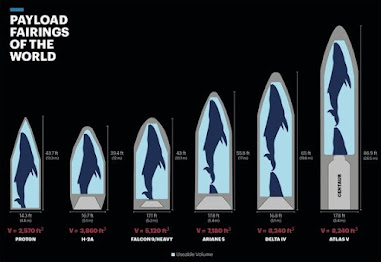The Falcon Heavy (often referred to as Falcon 9 Heavy or simply Falcon Heavy) is a partially reusable heavy-lift launch vehicle designed and manufactured by SpaceX, the private aerospace company founded by Elon Musk. It is currently one of the most powerful rockets in operation.
Key Details:
Design and Configuration:
- Core Structure: Falcon Heavy consists of three Falcon 9 nine-engine cores, which are strapped together to create a configuration with a total of 27 Merlin engines.
- Engines: The first stage consists of 27 Merlin engines (9 engines per core), generating over 5 million pounds of thrust at liftoff. The second stage is powered by a single Merlin vacuum engine optimized for operation in space.
- Reusability: Like the Falcon 9, the Falcon Heavy is designed for reusability. The side boosters are capable of landing back on Earth for refurbishment and reuse.
Payload Capacity:
- To Low Earth Orbit (LEO): Up to 63,800 kg (140,660 lbs).
- To Geostationary Transfer Orbit (GTO): Up to 26,700 kg (58,860 lbs).
- To Mars: Up to 16,800 kg (37,040 lbs).
- To Pluto: Up to 3,500 kg (7,720 lbs).
- Falcon Heavy's payload capacity makes it the most powerful operational rocket in the world by a factor of two.
First Launch:
- The first successful test flight of the Falcon Heavy was on February 6, 2018. It carried Elon Musk’s personal Tesla Roadster as a dummy payload, which is now on a heliocentric orbit around the Sun.
Notable Missions:
- Arabsat-6A: Launched in April 2019, this was Falcon Heavy's first commercial mission.
- STP-2: In June 2019, Falcon Heavy launched the U.S. Department of Defense’s STP-2 mission, which included various satellites for different agencies.
Comparison with Other Rockets:
- The Falcon Heavy is currently second only to NASA's Space Launch System (SLS) in terms of payload capacity.
- It surpasses the payload capabilities of many historical rockets, including the Space Shuttle and Saturn I.
Future Potential:
- Falcon Heavy is expected to play a key role in future deep space missions, including missions to the Moon, Mars, and possibly beyond. It will also likely continue to be used for launching heavy satellites and space station components.
Reusability Milestones:
- SpaceX has successfully landed and reused the side boosters from Falcon Heavy launches, which is a significant milestone in reducing the cost of access to space. The central core has been more challenging to recover, though they continue to improve on this aspect.
Falcon Heavy represents a significant step forward in space exploration capabilities, enabling a variety of missions that were previously impossible or prohibitively expensive.





.jpeg)

























.jpeg)














